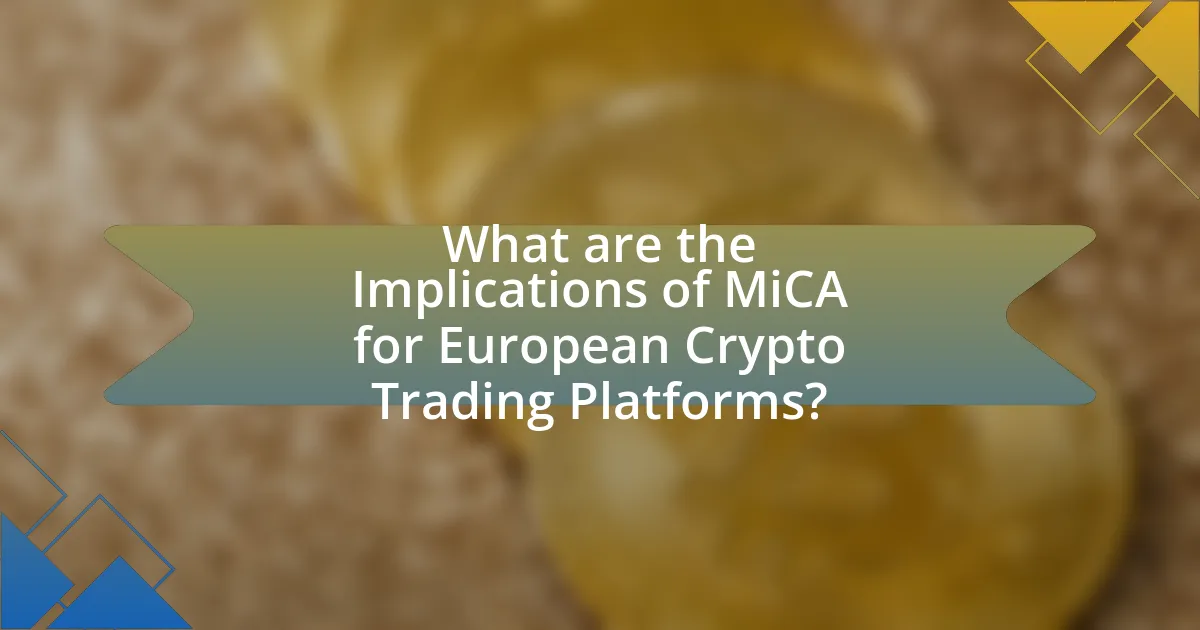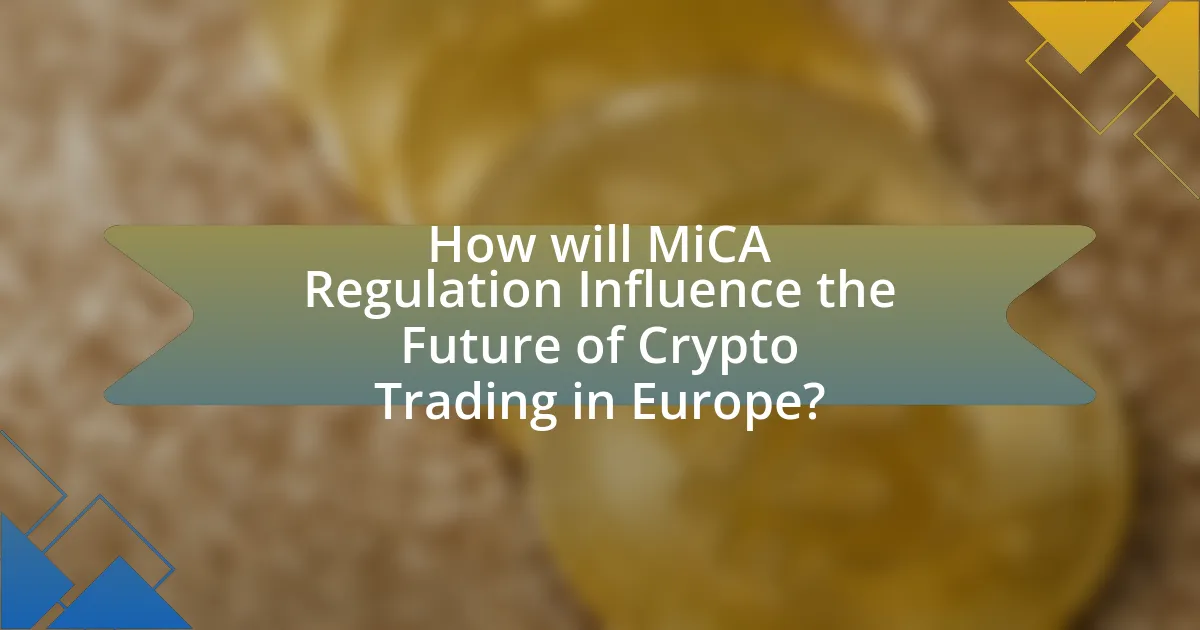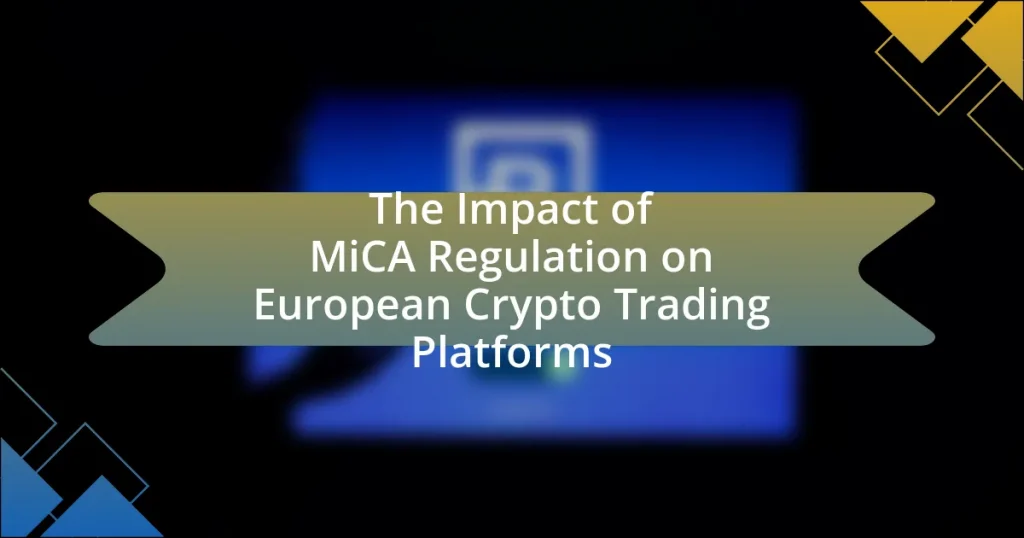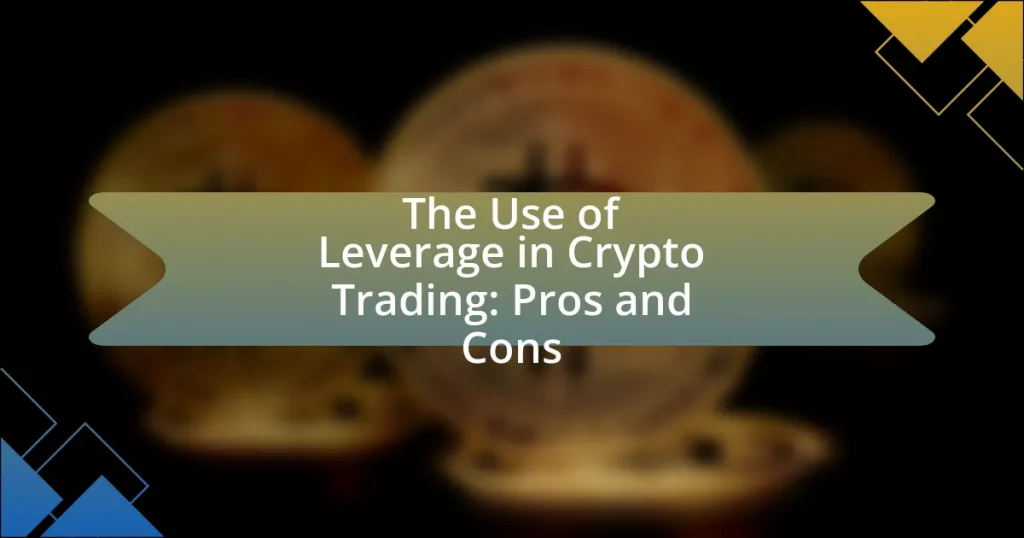The MiCA Regulation, or Markets in Crypto-Assets Regulation, is a legislative framework established by the European Union to regulate crypto-assets, ensuring consumer protection, market integrity, and financial stability. This article examines the implications of MiCA for European crypto trading platforms, detailing its key components, such as licensing requirements and operational standards, which aim to enhance transparency and accountability. It also addresses the challenges and compliance costs that platforms may face, particularly smaller entities, while highlighting how MiCA fosters innovation and institutional investment in the crypto sector. Additionally, the article explores best practices for compliance and the potential impact of MiCA on consumer trust in crypto trading.

What is the MiCA Regulation and its Purpose?
The MiCA Regulation, or the Markets in Crypto-Assets Regulation, is a legislative framework established by the European Union to regulate crypto-assets and ensure consumer protection, market integrity, and financial stability. Its purpose is to create a comprehensive regulatory environment for crypto-assets, addressing issues such as the issuance and trading of cryptocurrencies, stablecoins, and other digital assets, while also providing clarity for businesses operating in the crypto space. The regulation aims to mitigate risks associated with crypto-assets, such as fraud and market manipulation, by imposing requirements on issuers and service providers, thereby fostering innovation and ensuring a secure market for users.
How does the MiCA Regulation affect the crypto trading landscape in Europe?
The MiCA Regulation significantly impacts the crypto trading landscape in Europe by establishing a comprehensive legal framework for cryptocurrencies and related services. This regulation aims to enhance consumer protection, ensure market integrity, and foster innovation within the crypto sector. By requiring crypto asset service providers to obtain licenses and adhere to strict operational standards, MiCA promotes transparency and accountability, which can lead to increased investor confidence. Furthermore, the regulation aligns with existing EU financial regulations, facilitating cross-border operations and creating a more unified market for crypto trading across member states.
What are the key components of the MiCA Regulation?
The key components of the MiCA Regulation include the establishment of a comprehensive regulatory framework for cryptocurrencies, the classification of crypto-assets into categories, and the introduction of licensing requirements for crypto service providers. MiCA aims to enhance consumer protection, ensure market integrity, and promote innovation within the European Union’s digital finance landscape. Specifically, it categorizes assets into three groups: asset-referenced tokens, e-money tokens, and utility tokens, each with distinct regulatory obligations. Additionally, MiCA mandates that crypto service providers obtain authorization from national authorities, ensuring compliance with anti-money laundering (AML) and consumer protection standards. This regulatory approach is designed to create a safer environment for users and foster the growth of the crypto market in Europe.
How does MiCA aim to enhance consumer protection in crypto trading?
MiCA aims to enhance consumer protection in crypto trading by establishing a comprehensive regulatory framework that mandates transparency, accountability, and security for crypto asset service providers. This regulation requires firms to disclose essential information about their services, risks, and fees, thereby enabling consumers to make informed decisions. Additionally, MiCA introduces measures such as the requirement for firms to hold sufficient capital reserves and implement robust anti-fraud and anti-money laundering protocols, which further safeguard consumer interests. These provisions are designed to build trust in the crypto market and protect consumers from potential losses and fraudulent activities.
Why was the MiCA Regulation introduced?
The MiCA Regulation was introduced to create a comprehensive regulatory framework for cryptocurrencies and related services within the European Union. This regulation aims to enhance consumer protection, ensure financial stability, and foster innovation in the crypto market by establishing clear rules for issuers and service providers. The European Commission recognized the need for such regulation due to the rapid growth of the cryptocurrency market, which posed risks related to fraud, market manipulation, and lack of transparency. By implementing MiCA, the EU seeks to provide legal certainty and promote responsible growth in the crypto sector, thereby aligning it with existing financial regulations.
What challenges in the crypto market does MiCA address?
MiCA addresses several challenges in the crypto market, including regulatory uncertainty, consumer protection, and market integrity. By establishing a comprehensive regulatory framework, MiCA aims to provide clarity on the legal status of cryptocurrencies and related services, which has been a significant barrier for businesses and investors. Additionally, MiCA enhances consumer protection by requiring transparency in information provided to users and imposing strict rules on the issuance of crypto assets. Furthermore, it seeks to combat market manipulation and fraud, thereby promoting a safer trading environment. These measures are essential for fostering trust and stability in the rapidly evolving crypto landscape.
How does MiCA align with global regulatory trends?
MiCA aligns with global regulatory trends by establishing a comprehensive framework for cryptocurrency regulation that mirrors initiatives in other jurisdictions, such as the Financial Action Task Force (FATF) guidelines and the U.S. SEC’s focus on investor protection. This alignment is evident as MiCA emphasizes transparency, consumer protection, and market integrity, which are also central tenets of global regulatory efforts. For instance, MiCA’s requirements for issuers to provide clear information about their crypto assets and the obligations for service providers to implement anti-money laundering measures reflect similar standards set by the FATF, which aims to combat illicit financial activities globally.

What are the Implications of MiCA for European Crypto Trading Platforms?
The implications of the Markets in Crypto-Assets (MiCA) regulation for European crypto trading platforms include enhanced regulatory compliance, increased operational costs, and improved consumer protection. MiCA establishes a comprehensive regulatory framework that mandates crypto trading platforms to register with national authorities, ensuring adherence to anti-money laundering (AML) and consumer protection standards. This regulatory requirement may lead to higher operational costs for platforms as they invest in compliance infrastructure and legal expertise. Additionally, MiCA aims to foster market integrity and consumer trust by enforcing transparency and accountability measures, which could ultimately benefit the industry by attracting more institutional investors.
How will MiCA change the operational requirements for crypto trading platforms?
MiCA will change the operational requirements for crypto trading platforms by introducing comprehensive regulatory standards that mandate transparency, consumer protection, and risk management. Specifically, platforms will be required to implement robust governance structures, conduct regular audits, and ensure compliance with anti-money laundering (AML) and counter-terrorism financing (CTF) regulations. For instance, under MiCA, platforms must provide clear information about their services, fees, and risks associated with crypto assets, enhancing consumer trust and market integrity. Additionally, the regulation will enforce capital requirements, requiring platforms to maintain sufficient reserves to cover operational risks, thereby promoting financial stability within the crypto ecosystem.
What licensing requirements will platforms need to comply with under MiCA?
Platforms will need to obtain a license from the relevant national authority to operate under the Markets in Crypto-Assets (MiCA) regulation. This licensing requirement ensures that platforms comply with specific operational standards, including consumer protection measures, anti-money laundering protocols, and capital requirements. The MiCA framework mandates that platforms demonstrate adequate governance structures, risk management processes, and transparency in their operations to safeguard users and maintain market integrity.
How will MiCA impact the reporting and transparency obligations of platforms?
MiCA will significantly enhance the reporting and transparency obligations of platforms by mandating comprehensive disclosure of information related to crypto assets. Under MiCA, platforms must provide clear and accurate information about the nature of the crypto assets they offer, including risks, costs, and the rights of users. This regulation requires platforms to maintain detailed records of transactions and report them to regulatory authorities, ensuring a higher level of oversight and accountability. The European Securities and Markets Authority (ESMA) will oversee compliance, which reinforces the importance of transparency in the crypto market.
What are the potential risks and challenges for crypto trading platforms under MiCA?
Crypto trading platforms face several potential risks and challenges under the Markets in Crypto-Assets (MiCA) regulation. Firstly, compliance costs may increase significantly as platforms must adhere to stringent regulatory requirements, including licensing, reporting, and consumer protection measures. For instance, the need for comprehensive audits and legal consultations can strain financial resources, particularly for smaller platforms.
Secondly, the regulatory framework may limit the types of assets that platforms can offer, potentially reducing market competitiveness. MiCA categorizes crypto assets into different classes, and platforms may need to adjust their offerings to comply with these classifications, which could lead to a loss of existing customers seeking diverse investment options.
Additionally, the requirement for enhanced transparency and disclosure may expose platforms to greater scrutiny and liability. If platforms fail to meet these standards, they could face penalties or reputational damage, impacting user trust and engagement.
Lastly, the evolving nature of the regulatory landscape poses a challenge, as platforms must remain agile to adapt to potential amendments or additional regulations that may arise post-MiCA implementation. This uncertainty can hinder long-term strategic planning and investment in innovation.
How might compliance costs affect smaller trading platforms?
Compliance costs can significantly burden smaller trading platforms, potentially leading to reduced competitiveness and operational viability. These platforms often lack the financial resources to absorb the high costs associated with regulatory compliance, such as legal fees, technology upgrades, and ongoing reporting requirements. For instance, under the MiCA regulation, smaller entities may face costs that can exceed their profit margins, forcing them to either increase fees for users or limit their services. A study by the European Banking Authority indicates that smaller firms typically allocate a higher percentage of their revenue to compliance compared to larger firms, which can hinder their growth and market presence.
What are the implications of non-compliance with MiCA regulations?
Non-compliance with MiCA regulations can lead to significant legal and financial repercussions for crypto trading platforms. Entities that fail to adhere to these regulations may face hefty fines, which can reach up to 10% of their annual revenue, as stipulated by the European Commission. Additionally, non-compliance can result in the suspension or revocation of operating licenses, effectively barring platforms from conducting business within the European Union. This regulatory framework aims to enhance consumer protection and market integrity, and violations undermine these objectives, potentially leading to increased scrutiny from regulatory bodies and loss of consumer trust.

How will MiCA Regulation Influence the Future of Crypto Trading in Europe?
The MiCA Regulation will significantly influence the future of crypto trading in Europe by establishing a comprehensive legal framework that enhances investor protection and market integrity. This regulation aims to create a unified approach across EU member states, which will reduce regulatory fragmentation and provide clearer guidelines for crypto asset service providers. By requiring compliance with stringent operational standards, including transparency and risk management protocols, MiCA is expected to foster greater trust among investors. Furthermore, the regulation will likely encourage institutional participation in the crypto market, as firms will have a clearer understanding of their legal obligations. The implementation of MiCA is anticipated to lead to increased market stability and a more robust ecosystem for crypto trading in Europe.
What opportunities does MiCA create for innovation in the crypto sector?
MiCA creates opportunities for innovation in the crypto sector by establishing a clear regulatory framework that fosters trust and security among users and investors. This regulatory clarity encourages new projects and startups to enter the market, as they can operate within defined legal parameters, reducing the risk of regulatory penalties. Furthermore, MiCA’s provisions for stablecoins and digital asset service providers promote the development of innovative financial products and services, enhancing competition and consumer choice. The regulation also facilitates cross-border operations within the EU, allowing companies to scale their innovations more effectively across member states.
How might MiCA foster greater institutional investment in crypto?
MiCA, or the Markets in Crypto-Assets regulation, may foster greater institutional investment in crypto by providing a clear regulatory framework that enhances investor confidence. This regulation establishes standardized rules for crypto assets, which reduces uncertainty and risk for institutional investors. By ensuring compliance and consumer protection, MiCA addresses key concerns that have historically hindered institutional participation in the crypto market. For instance, the European Commission’s proposal aims to create a harmonized approach across EU member states, facilitating easier access and investment opportunities for institutions. This structured environment is likely to attract more institutional capital, as evidenced by the growing interest in regulated financial products linked to cryptocurrencies.
What role will MiCA play in shaping consumer trust in crypto trading?
MiCA will enhance consumer trust in crypto trading by establishing a comprehensive regulatory framework that ensures transparency and accountability among crypto asset service providers. This regulation mandates clear disclosure of information, including risks associated with crypto investments, which helps consumers make informed decisions. Additionally, MiCA introduces stringent requirements for the licensing and operation of crypto platforms, thereby reducing the risk of fraud and increasing consumer confidence. The implementation of these standards is expected to foster a safer trading environment, as evidenced by the growing demand for regulatory clarity in the crypto market, which has been highlighted in various industry reports.
What best practices should crypto trading platforms adopt to comply with MiCA?
Crypto trading platforms should adopt robust compliance frameworks, including thorough customer due diligence, transparent reporting practices, and effective risk management strategies to comply with MiCA. Implementing Know Your Customer (KYC) procedures ensures that platforms verify the identity of their users, which is essential for preventing fraud and money laundering. Additionally, platforms must maintain accurate records of transactions and report suspicious activities to regulatory authorities, aligning with MiCA’s emphasis on transparency. Furthermore, establishing a comprehensive risk management system helps platforms identify and mitigate potential risks associated with crypto assets, ensuring they operate within the regulatory framework. These practices not only facilitate compliance with MiCA but also enhance the overall integrity and trustworthiness of the crypto trading ecosystem.
How can platforms prepare for the implementation of MiCA regulations?
Platforms can prepare for the implementation of MiCA regulations by conducting a comprehensive compliance assessment to identify necessary changes in their operations. This involves reviewing existing policies, procedures, and technologies to ensure alignment with MiCA’s requirements, such as transparency, consumer protection, and anti-money laundering measures. Additionally, platforms should invest in staff training to enhance understanding of regulatory obligations and establish robust reporting mechanisms to monitor compliance. The European Commission’s proposal for MiCA emphasizes the need for clear governance structures and risk management frameworks, which platforms must adopt to mitigate potential legal and financial risks associated with non-compliance.
What strategies can platforms use to enhance compliance and mitigate risks?
Platforms can enhance compliance and mitigate risks by implementing robust regulatory frameworks, conducting regular audits, and utilizing advanced technology for monitoring transactions. Establishing a comprehensive compliance program ensures adherence to the MiCA regulation, which mandates transparency and accountability in crypto trading. Regular audits help identify potential vulnerabilities and ensure that platforms are operating within legal parameters. Additionally, employing technologies such as artificial intelligence and machine learning can facilitate real-time monitoring of transactions, enabling platforms to detect suspicious activities promptly. These strategies collectively contribute to a safer trading environment and align with regulatory expectations, thereby reducing the risk of non-compliance and associated penalties.















